I remember when the Hornady A-MAX bullet first hit the market. It was a great bullet, very accurate and with some hunting applications on light skinned game at extended ranges. Plugging in the new higher ballistic coefficient number into ballistics calculators provided a promise of performance beyond what most of us were seeing in our SMKs. I made the switch.
But Hornady measured what careful shooters had noticed; the ballistic coefficient of the polymer tipped rounds changed in flight, deforming as they melted. Hornady included their “heat shield” technology with their ELD bullets to fix this, but still had the problem that the polymer material would shrink and pose other challenges during the manufacturing process.
The solution was obvious, make an open tip match bullet like everyone else.
Hornady has chosen a different path with their A-TIP Match bullet line, instead placing a machined aluminum tip atop their Advanced Manufacturing Process (AMP) jacketed bullets.
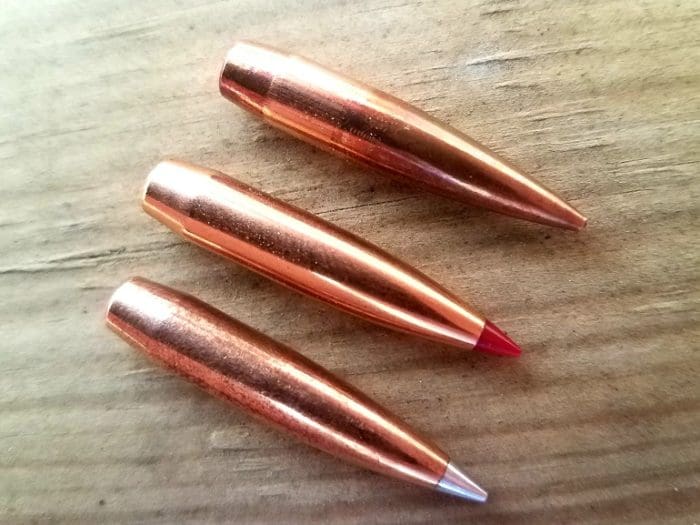
Aluminum tipped bullets aren’t really anything new. But precision aluminum tipped bullets in the “modern” era are.
Hornady’s use of aluminum for the tip means that the are able to machine a lightweight, but long point into the bullet that is simply not possible in a polymer tipped bullet. It’s also not possible to have the same shape and corresponding sectional density with a solid bullet or traditional wrapped jacket with the lighter weight material up front.
The overall profile is obviously different from other bullets, even other Very Low Drag profile projectiles. The A-TIP’s ballistic coefficients and sectional densities of each of their listed calibers are extremely impressive. The published numbers, as least for the rounds I’ve shot, also appear to be accurate.
Beyond just the materials and construction, the manufacturing process itself is a bit different for the A-TIP. The overall goal, as always, is consistency. In this case, that also means as little human interaction as possible.
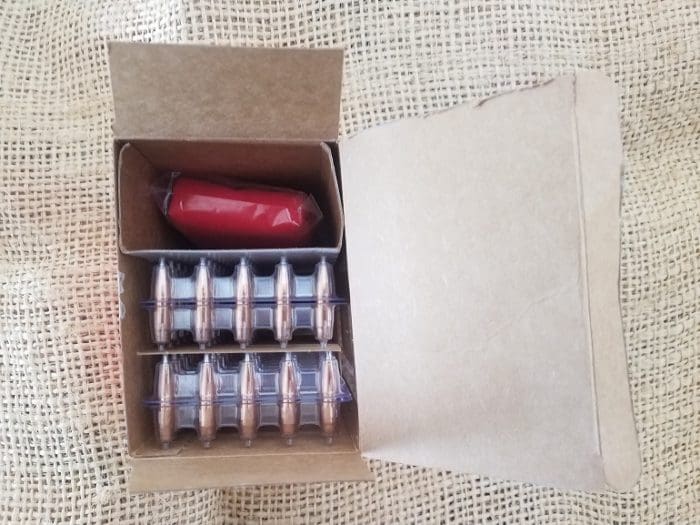
For instance, instead of the rounds ending up in a bin and then in a box, each bullet is placed individually, by machine, in a plastic carrier. But wait, there’s more.
Each bullet is dropped in series, and each box is labeled with that number. So you don’t get bullet number 1 of the lot and bullet number 1,383 of the lot along with 98 others from somewhere in the middle of the lot. You get numbers 1-100 packaged as they were produced in that order.
That should produce a product even more consistent than what is possible with traditional lots.

That’s because traditional lots are usually large, and there may be some variation in machining within the lots, depending on how each company manages their production. It’s typically not much, but that’s why precision shooters pick and note specific lots.
Most shooters do what I do; buy a large amount of a specific lot of bullets and then weigh each round to set aside the outliers.
Unfortunately, to test if the A-TIP method is superior, I’d need a wide variance in manufacture number, like number 1 and number 500,000, and those numbers simply aren’t available from Hornady yet. In theory, though, it makes sense.
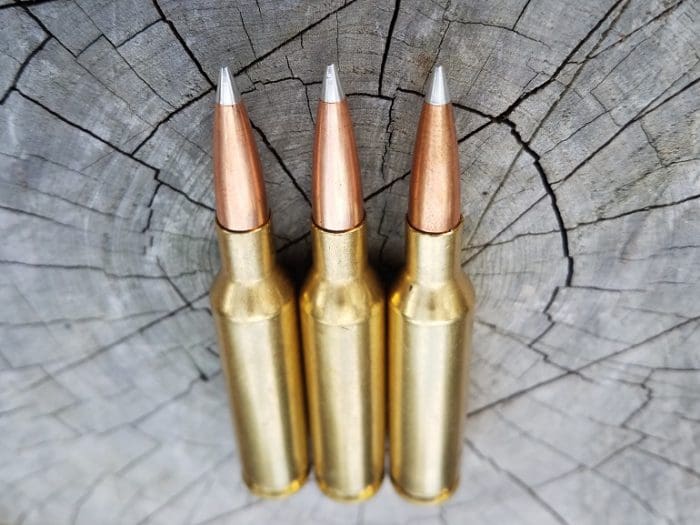
It really is a beautiful bullet. With it’s ultra-sleek design and bi-metal appearance, each round could easily pass for jewelry.
It’s also very pointy, right our of the box. There is no open tip or hollow point. Each round comes to a simple, sharp point.
The junction line of the metals are so close that I can’t feel them with my finger, although I can feel it with my right thumbnail (not my left, I might need to see a doctor about that).
Hornady makes a lot of great ammunition, and more and more shooters are switching to shooting their loaded commercial ammunition instead of rolling their own. But if you look at the top brackets of most of the long range rifle shooting sports, you won’t see Hornady projectiles well represented.
They’ve attempted to fix that with the their ELD Match line, and you definitely see more folks using those bullets. But the A-TIP bullet shows a full commitment to playing in the same extreme precision leagues with the smaller manufacturers.
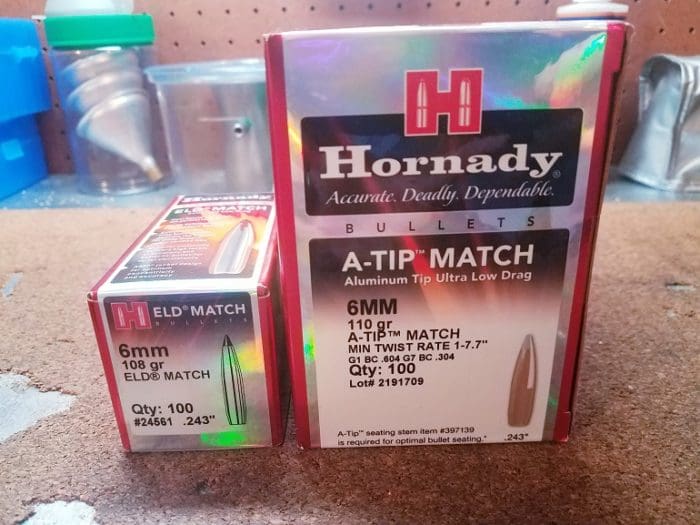
The real challenge for Hornady with the A-TIP bullet isn’t just making a good bullet to compete with Berger and some of the others. They also need to produce a noticeably better bullet than their other options, like the much lower priced Hornady ELD Match bullet.
I wanted to see how those two bullets would compare to each other, and if there was any measurable difference between the 110gr 6mm/.243 A-TIP bullet and Hornady’s current 108gr ELD Match bullet, so I got to shooting a little over 100 rounds of each.
My experiment would take the better part of five months and a lot of waiting.

First I need to make the rounds. I’d be shooting all of these out of my Kiote Rifles LRP chambered in 6mm SLR. I already had a couple hundred rounds of ELD Match bullets, but I got 100 more. After quite a bit of waiting, I was able to purchase 100 rounds of the 6mm A-TIP bullet, and TTAG got its hands on 100 more.
As for the cartridge construction, I used new Winchester brass, then resized and neck turned each piece. I used the same lot of CCI BR2 primers and used the same lot of Hybrid 100V powder for all of the shooting.
Again, the A-TIP bullets are dropped into their packaging individually, with as little human contact as necessary. That means they come with a slight amount of machine oil still coating each bullet. You’ll need to wipe this off the bullets, so Hornady supplies a Crown Royal-style felt bag just for that purpose.

I assumed I would just put the rounds in the bag a few at a time, and then move them around a bit, load them up and shoot them. Big mistake.
The lubricant is harder to get off than that, and if you don’t remove it, the white smoke produced on firing is significant. I found that I had to individually wipe every single round clean, and that a soft paper towel was more effective that the supplied pouch.
The first big nod to an extremely consistent bullet were the weights. With a Lyman digital scale, I measured each projectile. I measured all 100 A-TIP bullets in a row.
The heaviest was 110.1 grains. There was only one of those. The lightest was 109.7, and there was only one of those. There were five that were 110 even. The rest — all 93 of them — weighted 109.9 grains. None of the lighter or heavier bullets were clustered, they were spread out through the group of 100.

The 108 grain ELD-Match bullet is also very impressive, just not quite as much. All of these bullets were from the same box. The heaviest was 108.2, and there were four of those. The lightest was 107.8, and there were 6 of those. Another six were 108.1. There were exactly 42 that weighed 108 grains even and 42 that weighted 107.9. That’s good, just not as good as the A-TIP’s consistnecy.
I performed an abbreviated load development for each round. I wanted to use the same charge for both bullets and still get acceptable groups. This was very simple, as every mid to high pressure load I put through the rifle printed five groups under 1/2 MOA.
As I was already using about 10% of my barrel life just for this test, I settled on a mid-pressure load. The Hybrid 100V powder was pushing the 110 grain A-TIP bullet through the 26″ barrel at an average speed of 2,921 fps, measured with a Magneto Speed chronograph. The 108 grain ELD Match bullet averaged 2,915 fps.
I have no explanation why the longer A-TIP bullet was actually 6 fps faster than the ELD bullet that’s 2 grains lighter, but it was. That’s a negligible difference in speed, and in fact the A-TIP bullet’s extreme spread fit (just barely) inside the extreme spread of the ELD Match bullet.
Now that I had my bullets cleaned and all loaded up, it was time to head to the range.
My range set-up was fairly simple. I rested my rifle, topped with a Nightforce 20X scope, into a Caldwell Stinger shooting rest.
I placed a single steel silhouette target at 1,200 yards. This is about as far as I can shoot at my range, but it’s also about 100 yards from were this particular load goes transonic. I dug in the points where the rest touched the ground, bagged up the rest additionally, and then bagged up the gun in the rest. I got as close to a bench rest position as I could.
Just to validate the set-up, I shot a few 100-yard groups. This set-up required very little contact with the gun. Recoil was practically non existent, and 1/3 MOA groups were easy.
It took some time to get all of the shooting done for this review. I did all of the testing in groups of 20. I had to wait for a clear day with a zero value wind for the shooting in order to reduce the variable of my own wind-call errors.
I have the luxury of a weather data collection tower that’s relatively parallel to the 1200 yard mark of my range. With a Kestrel weather meter as well, I could measure the wind both at my target and at the gun at the same time.
I only shot when both read zero. I also only shot on days where the local and NOAA weather radio said the prevailing wind was north, a zero value for this range. That involved a lot of waiting and 10 separate days of shooting.
For the shooting, I cleaned the barrel, then shot 5 fouling shots, then shot for record. At the end of the first 100 rounds, I fully cleaned the barrel again, shot 5 fouling shots, and shot for record for the next 100.
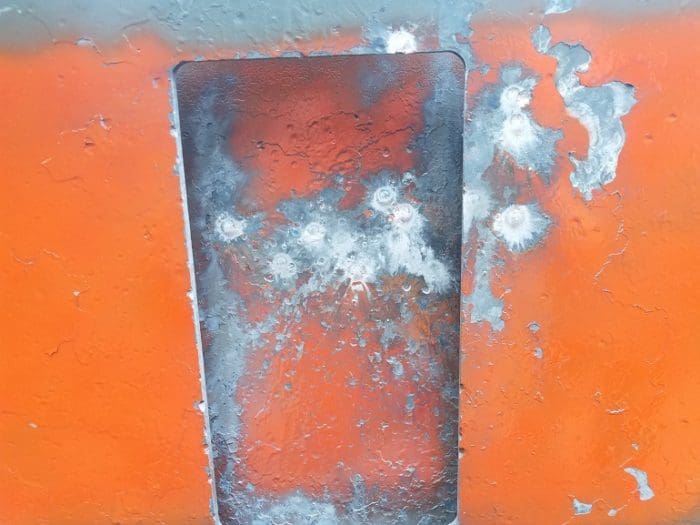
The average of all 100 Hornady ELD Match 6mm bullets was a 12.3″ wide horizontal spread and a 9.2″ vertical spread.
The average of all 100 Hornady A-TIP 6mm bullets was a 10.6″ wide horizontal spread and a 9″ vertical spread.
There was actually a slightly smaller variance in the shot groups with the A-TIP, but only on the vertical spread. The horizontal was both smaller in size, and a smaller variance, for the A-TIP over the ELD Match.
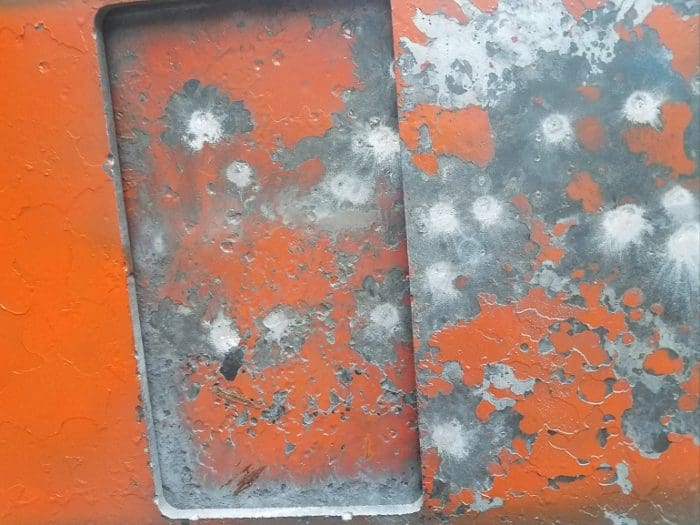
When controlling for every variable I could reasonably control for, the A-TIP did perform slightly better in terms of bucking the wind. That said, even as controlled as it was, my experiment doesn’t have data to completely tell the whole story of both bullets and the benefits of the A-TIP Match manufacturing and packaging process.
That would take shooting different A-TIP bullets that are at least tens of thousands apart in manufacture series to see if there were significant changes in the bullet weight, dimensions or performance for that. After all, there are not likely to be big changes in round 1 to round 100, but there might be from round 1 and round 80,000. I suspect it would take even more.
I shot the A-TIP Match bullets first, and then the ELD Match. I intentionally didn’t make any adjustments when switching to the ELD Match round, just to see where it would land on the target relative to the A-TIP.
I was surprised when the first ELD Match round fired didn’t strike the target at all, but under it. I fired 9 more round and enlisted a spotter to double-check what I was seeing. The rounds were landing just under the target, about 20″ below the point of impact of the A-TIP bullet.
Going back to my Point Mass Ballistic Solver software, I played around with all of the variables to verify what I was seeing. The Hornady website states the G7 ballistic coefficient of the A-TIP Match bullet to be .304. That is a very, very slick bullet.
The G7 ballistic coefficient of the ELD Match bullet is a great, but again not as great, .270. That BC alone, and not the 6 fps MV variation, made up the difference in drop entirely.
Obviously, there was also a difference in windage, with the A-TIP Match making a small in number, but larger in percentage advantage. Even with careful observation and data showing a zero value wind at the shooter and the target, there is still about 3/4 MOA horizontal variation in my best group with either bullet.
This is almost certainly more than can be accounted for in just mechanical and shooter error, and shows that, no matter what you can see or measure, wind is our invisible, inconsistent nemesis.
In short, the performance difference of the A-TIP Match is there. I’m sure for folks shooting Extremely Long Distance matches it will make an even bigger difference. BUT…there’s a huge price per bullet difference as well.
The ELD Match is a great bullet at 23 cents a piece. The A-TIP Match is an exceptional bullet. At 70 cents a piece, it’s much more expensive than the more traditional Berger bullet (45 cents) and is triple the price of the Hornady ELD Match bullet.
Is the A-TIP Match three times better? No…and it doesn’t matter.
If you’re a precision shooter and you need a bullet to perform like the ELD Match does, then buying the ELD Match makes sense. But if you need a bullet to perform better than that, the ELD Match bullet won’t do at any price.
For that better performance, you’ll need to step up, and the A-TIP Match bullet is just that step.
Me? I need all the help I can get.

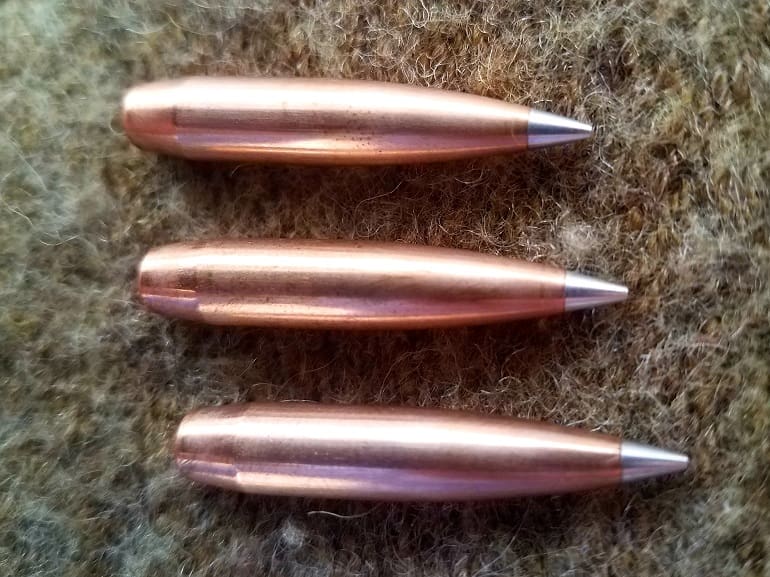



I’m waiting for the “T” tip. T being Tungsten. Now you’re cooking with gas.
A Tungsten tip round would be a mistake, but tungsten carbide core rounds have been around for some time.
Back in 2009 a dude shot from some distance, his round went through a metal door, hit my side plate at a shallow angle, skipped off it, and hit the guy behind me in the thigh. It shattered his femur like Jell-O, but did not exit his pant leg, depositing the round In his boot. I found it providing his patient care. I still have it.
“The solution was obvious, make an open tip match bullet like everyone else.”
I’m glad they didn’t, because the People’s Republic of New Jersey places severe restrictions on “hollow-point” bullets, not based on their expansion, but based on their looks, and open tip match bullets look like “hollow points.” This means if the cops find even one OTM bullet in the trunk of your car, you’re going to prison for a long time. Yeah, it sucks to live in the PRNJ.
I went to New Jersey once, you have my sympathy.
Does it count if you point a OTM bullet? If not problem solved. You get more consistent BC and your PRNJ compliant.
Hornady has been thinking out of the box the last few years with their designs. This is cool stuff. Too rich for my blood and too far out of my skill set to care but cool none the less.
Ahhohh Creedmoore, these bullets are making that 243 shine.
Great write up Jon.
Going to have to give those a try.
With the 143 eld-x in 6.5, mine holds a bit under a half an inch.
If I am shooting off the bipod and a rear bag, that’s about where I am too.
“I have no explanation why the longer A-TIP bullet was actually 6 fps faster than the ELD bullet that’s 2 grains lighter”
A heavier bullet can have a longer dwell time in the barrel, resulting in higher velocity given the same charge.
I don’t think I understand.
The distance is fixed. It is 26in. If a bullet has a longer dwell time, that means it is covering those 26 inches in a longer amount of time. That means it is slower.
How can a bullet that is moving slower, be faster?
Because of *when* it’s moving slower.
You’re right that the barrel length is constant, but remember that the bullet is being pushed by the product of a chemical reaction – the force isn’t static, it grows as more powder burns.
A heavier bullet in the same caliber is almost certainly longer than a lighter one – this is the only way you can add mass while keeping the same diameter. So you’re not just increasing mass (inertia) but also bearing surface (friction).
Overcoming both of those forces means the larger bullet has more barrel in front of it when pressure peaks than the smaller bullet did – and therefore more time and barrel distance under higher pressure, resulting in a higher velocity at the muzzle.
I don’t mean to be critical, because I get what you were going for here, but this is a great demonstration of why it’s important to never substitute things in a reloading recipe. The results aren’t always immediately intuitive or easily predictable.
I get the science, (although a longer bullet does not necessarily have a more bearing surface, this design is an example of just that).
What I don’t understand is the concept that a longer dwell time can mean a faster muzzle velocity. Longer dwell time means slower. As in, covering the same amount of distance in a longer amount of time is the very definition of slower.
Speed is distance over time. If distance is fixed and time is longer, it is slower.
I think what That Jason meant was that the heavier bullet takes longer to start moving, giving the propellant more time to burn and therefore is accelerating under higher pressure than the ligher bullet. Not the overall time spent inside the barrel.
JWT – I get your point (and I haven’t run the numbers on this so I don’t know if Jason is correct in this case). But you’re talking about AVERAGE velocity, in which case you are correct. By definition, if a bullet takes a longer time to cover a fixed distance (barrel length) then it has a slower AVERAGE velocity over that distance. However we’re comparing MUZZLE velocity, which is the instantaneous (not average) velocity at a single point (when the bullet leaves the muzzle). You can have an object with a slower average velocity over a distance, but a higher instantaneous velocity at the end of that distance, if the acceleration curves are different. As a crude example: Olympic sprinter and fat old dude in a race. At the starting gun, fat old dude goes for all he’s worth the entire distance, while the Olympic sprinter slowly walks for the first 90% of the race, then goes full power for the last little bit. Fat old dude crosses the line first (higher average velocity) but only moving at 8 mph. Olympic sprinter crosses the finish line second (lower average velocity) but moving at 30 mph (higher instantaneous/muzzle velocity).
I think Jason is saying that the extra mass of the heavier bullet accelerates slower at the start, which allows the pressure to increase to a higher point than with the lighter bullet, and as a result the area under the pressure curve (total work done on the bullet) is higher, causing a higher muzzle velocity (but potentially with a lower average velocity). Like I said, I haven’t actually done any modeling/analysis to see if that’s actually the case here,, so I”m not saying he;s right per se. But it definitely is possible that an object can have a higher final velocity but a lower average velocity over a fixed distance, if its acceleration curve differs from another object over that same distance.
Ah, that makes sense! I can definitely understand how a heavier bullet (especially one that must be put slightly deeper into the case) allows for more pressure to be built up behind it, generating more speed at the muzzle. Thanks y’all.
Check out the bullet ballistics chart here
https://gundigest.com/gear-ammo/reloading/bullet-ballistics
Imagine the heavier bullet loses the race in the first .0005 seconds by only traveling 2.5 inches instead of 2.8 inches.
The heavier bullet is now under high pressure for an additional .3″ of barrel.
It’s not going to have the best time in the quarter mile because it spent too long in first gear. But it will have the best top speed off the radar gun – it had a better third gear.
Got it. Thanks for sticking with me there.
JWT’s reviews and testing are half the reason I still come to TTAG. Outstanding information and explanation. Thank you!
Thanks.
What twist are you using in your 6SLR?
1:7
Here’s another manufacturer of Aluminium tipped projectiles, but also with a rebated boat tail.
Unfortunately no 6 or 6.5 mm.
https://www.alcobullets.com/
ระบบออโต้รวดเร็วจบในที่เดียว Pubgbet สล็อตออนไลน์ คาสิโน เกมไพ่ พนันกีฬาต่างๆ กีฬา ฟุตบอล บาส มวย มีโปรโมชั่นเด็ดทุกวัน เครดิตฟรี ทุกวัน โบนัสฝากครั้งแรก โบนัสฝากรายวัน ฝากถอนได้ไม่อั้น ไม่กำจัดต่อวัน
เว็บหวยออนไลน์ที่มาแรงที่สุดในตอนนี้ CHOKEDEE88.COM หวยเยอะที่สุด ถูกจริง จ่ายจริง ฝาก-ถอน รวดเร็ว สมัครหวย
Comments are closed.